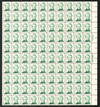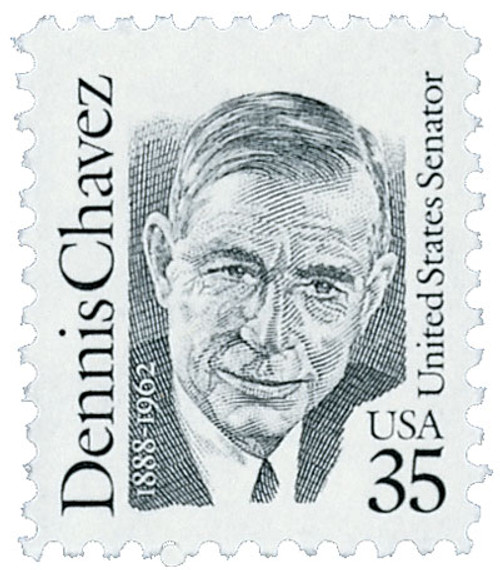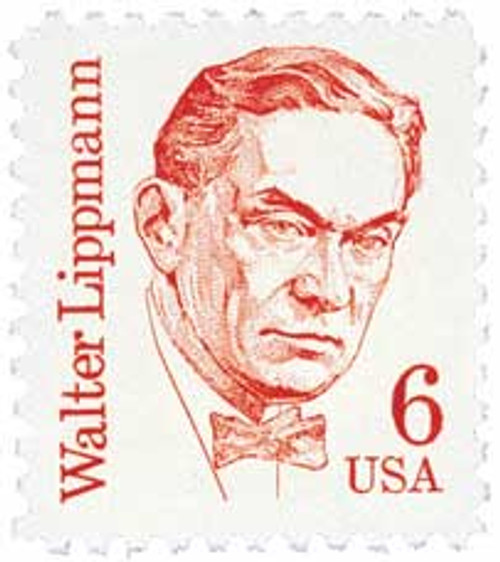
# 1852 - 1985 9c Great Americans: Sylvanus Thayer
U.S. #1852
1985 9¢ Sylvanus Thayer
Great Americans Series
- 23rd stamp in the Great Americans Series
- Honors the “Father of West Point”
- Issued for Thayer’s 200th birthday in his hometown
Stamp Category: Definitive
Series: Great Americans
Value: 9¢; for “make-up” postage
First Day of Issue: June 7, 1985
First Day City: Braintree, Massachusetts
Quantity Issued: 73,000,000
Printed by: Bureau of Engraving & Printing
Printing Method: Engraved
Format: Panes of 100
Perforations: 11
Color: Dark green
Why the stamp was issued: This stamp was most often used for make-up postage. It was issued two days before Thayer’s 200th birthday in his hometown.
About the stamp design: Robert Anderson created the portrait on this stamp, based on a painting by Robert Weir that hangs in the West Point Museum at the US Military Academy. It pictures Thayer in his early colonel’s uniform.
First Day City: The First Day ceremony for this stamp was originally scheduled for June 9th at West Point, but it was changed to June 7th at the Thayer Academy in Braintree, Massachusetts. In speaking of Thayer’s leadership of the academy he founded, one of the day’s speakers described him as “an orderly tornado. By acute perception he identified problems detrimental to the Academy, then – like a skilled surgeon – those ailing parts he could not heal he amputated.” The day after the stamp ceremony, Braintree celebrated its own 345th anniversary as an incorporated city. The day’s festivities included the placing of a plaque at Thayer’s family home.
About the Great Americans Series: The Great Americans Series was created to replace the Americana Series. The new series would be characterized by a standard definitive size, simple design, and monochromatic colors.
This simple design included a portrait, “USA,” the denomination, the person’s name, and in some cases, their occupation or reason for recognition. The first stamp in the new series was issued on December 27, 1980. It honored Sequoyah and fulfilled the new international postcard rate that would go into effect in January 1981.
The Great Americans Series would honor a wider range of people than the previous Prominent Americans and Liberty Series. While those series mainly honored presidents and politicians, the Great Americans Series featured people from many fields and ethnicities. They were individuals who were leaders in education, the military, literature, the arts, and human and civil rights. Plus, while the previous series only honored a few women, the Great Americans featured 15 women. This was also the first definitive series to honor Native Americans, with five stamps.
The Bureau of Engraving and Printing (BEP) produced most of the stamps, but private firms printed some. Several stamps saw multiple printings. The result was many different varieties, with tagging being the key to understanding them. Though there were also differences in perforations, gum, paper, and ink color.
The final stamp in the series was issued on July 17, 1999, honoring Justin S. Morrill. Spanning 20 years, the Great Americans was the longest-running US definitive series. It was also the largest series of face-different stamps, with a total of 63.
Click here for all the individual stamps and click here for the complete series.
History the stamp represents: “The Father of West Point,” Sylvanus Thayer was born on June 9, 1785, in Braintree, Massachusetts. During his 16 years as superintendent, Thayer transformed West Point into one of the finest military academies in the world.
Thayer lived with his parents on their family farm until he was eight years old, at which time he went to live with his uncle in New Hampshire. He attended school there and went on to study advanced mathematics at Dartmouth College and graduated as the valedictorian of his class.
Thayer then received an appointment to West Point from President Thomas Jefferson. He completed his coursework in one year and was made a second lieutenant in 1808. Thayer’s first job in this role was to oversee the construction of Fort Warren in Boston Harbor. After directing the defense of Norfolk, VA, during the War of 1812, he was promoted to major.
In 1815, Thayer went to Europe to study at the French École Polytechnique for two years. While there, he assembled a large collection of science and mathematics books. Upon his return to the US in 1817, President James Monroe appointed him superintendent of West Point to replace the resigning Alden Partridge.
Thayer became known as “the Father of West Point” because he reshaped the United States Military Academy. Under his leadership, West Point became the nation’s first college of engineering. Thayer’s curriculum reforms became the model for technical education across the United States. He instituted military discipline and a rigorous course of study. By improving the curriculum and class structure, he created one of the finest military academies in the world.
After 16 years as head of West Point, Thayer resigned in 1833 due to a disagreement with President Andrew Jackson. The following year he was made an associate fellow in the American Academy of Arts and Sciences. Thayer then returned to military service with the Army Corps of Engineers. He spent most of the next 30 years as the chief engineer for Boston. Thayer oversaw the construction of Forts Warren and Independence.
During this time Thayer was a member and later president of the Board of Engineers for Coast Defenses. He also briefly commanded the Corps of Engineers for a year when its commander took a leave of absence. Due to an extended sick leave, Thayer didn’t participate in the Civil War. However, Fort Thayer was built and named after him in 1861 in Washington, DC. He retired from the Army on June 1, 1863.
In 1867, Thayer donated $40,000 to the trustees of his alma mater, Dartmouth College, to create the Thayer School of Engineering. Two years later, he helped create the Military Academy’s Association of Graduates. After his death on September 7, 1877, the Thayer Academy was established in Braintree, Massachusetts, according to his wishes. And in 1958, West Point established the Sylvanus Thayer Award.
U.S. #1852
1985 9¢ Sylvanus Thayer
Great Americans Series
- 23rd stamp in the Great Americans Series
- Honors the “Father of West Point”
- Issued for Thayer’s 200th birthday in his hometown
Stamp Category: Definitive
Series: Great Americans
Value: 9¢; for “make-up” postage
First Day of Issue: June 7, 1985
First Day City: Braintree, Massachusetts
Quantity Issued: 73,000,000
Printed by: Bureau of Engraving & Printing
Printing Method: Engraved
Format: Panes of 100
Perforations: 11
Color: Dark green
Why the stamp was issued: This stamp was most often used for make-up postage. It was issued two days before Thayer’s 200th birthday in his hometown.
About the stamp design: Robert Anderson created the portrait on this stamp, based on a painting by Robert Weir that hangs in the West Point Museum at the US Military Academy. It pictures Thayer in his early colonel’s uniform.
First Day City: The First Day ceremony for this stamp was originally scheduled for June 9th at West Point, but it was changed to June 7th at the Thayer Academy in Braintree, Massachusetts. In speaking of Thayer’s leadership of the academy he founded, one of the day’s speakers described him as “an orderly tornado. By acute perception he identified problems detrimental to the Academy, then – like a skilled surgeon – those ailing parts he could not heal he amputated.” The day after the stamp ceremony, Braintree celebrated its own 345th anniversary as an incorporated city. The day’s festivities included the placing of a plaque at Thayer’s family home.
About the Great Americans Series: The Great Americans Series was created to replace the Americana Series. The new series would be characterized by a standard definitive size, simple design, and monochromatic colors.
This simple design included a portrait, “USA,” the denomination, the person’s name, and in some cases, their occupation or reason for recognition. The first stamp in the new series was issued on December 27, 1980. It honored Sequoyah and fulfilled the new international postcard rate that would go into effect in January 1981.
The Great Americans Series would honor a wider range of people than the previous Prominent Americans and Liberty Series. While those series mainly honored presidents and politicians, the Great Americans Series featured people from many fields and ethnicities. They were individuals who were leaders in education, the military, literature, the arts, and human and civil rights. Plus, while the previous series only honored a few women, the Great Americans featured 15 women. This was also the first definitive series to honor Native Americans, with five stamps.
The Bureau of Engraving and Printing (BEP) produced most of the stamps, but private firms printed some. Several stamps saw multiple printings. The result was many different varieties, with tagging being the key to understanding them. Though there were also differences in perforations, gum, paper, and ink color.
The final stamp in the series was issued on July 17, 1999, honoring Justin S. Morrill. Spanning 20 years, the Great Americans was the longest-running US definitive series. It was also the largest series of face-different stamps, with a total of 63.
Click here for all the individual stamps and click here for the complete series.
History the stamp represents: “The Father of West Point,” Sylvanus Thayer was born on June 9, 1785, in Braintree, Massachusetts. During his 16 years as superintendent, Thayer transformed West Point into one of the finest military academies in the world.
Thayer lived with his parents on their family farm until he was eight years old, at which time he went to live with his uncle in New Hampshire. He attended school there and went on to study advanced mathematics at Dartmouth College and graduated as the valedictorian of his class.
Thayer then received an appointment to West Point from President Thomas Jefferson. He completed his coursework in one year and was made a second lieutenant in 1808. Thayer’s first job in this role was to oversee the construction of Fort Warren in Boston Harbor. After directing the defense of Norfolk, VA, during the War of 1812, he was promoted to major.
In 1815, Thayer went to Europe to study at the French École Polytechnique for two years. While there, he assembled a large collection of science and mathematics books. Upon his return to the US in 1817, President James Monroe appointed him superintendent of West Point to replace the resigning Alden Partridge.
Thayer became known as “the Father of West Point” because he reshaped the United States Military Academy. Under his leadership, West Point became the nation’s first college of engineering. Thayer’s curriculum reforms became the model for technical education across the United States. He instituted military discipline and a rigorous course of study. By improving the curriculum and class structure, he created one of the finest military academies in the world.
After 16 years as head of West Point, Thayer resigned in 1833 due to a disagreement with President Andrew Jackson. The following year he was made an associate fellow in the American Academy of Arts and Sciences. Thayer then returned to military service with the Army Corps of Engineers. He spent most of the next 30 years as the chief engineer for Boston. Thayer oversaw the construction of Forts Warren and Independence.
During this time Thayer was a member and later president of the Board of Engineers for Coast Defenses. He also briefly commanded the Corps of Engineers for a year when its commander took a leave of absence. Due to an extended sick leave, Thayer didn’t participate in the Civil War. However, Fort Thayer was built and named after him in 1861 in Washington, DC. He retired from the Army on June 1, 1863.
In 1867, Thayer donated $40,000 to the trustees of his alma mater, Dartmouth College, to create the Thayer School of Engineering. Two years later, he helped create the Military Academy’s Association of Graduates. After his death on September 7, 1877, the Thayer Academy was established in Braintree, Massachusetts, according to his wishes. And in 1958, West Point established the Sylvanus Thayer Award.




















